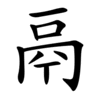鬲
| ||||||||
Translingual
| Stroke order | |||
|---|---|---|---|
 | |||
Han character
鬲 (radical 193, 鬲+0, 10 strokes, cangjie input 一口月中 (MRBL), four-corner 10227, composition ⿱𠮛⿵冂⿱䒑丨(GHT) or ⿱𠮛⿵𦉪丅(JK))
- Kangxi radical #193, ⿀.
Related characters
- 徹 (earlier forms also had a pot, later replaced with 育)
References
- KangXi: page 1458, character 20
- Dai Kanwa Jiten: character 45672
- Dae Jaweon: page 1991, character 2
- Hanyu Da Zidian: volume 7, page 4587, character 1
- Unihan data for U+9B32
Chinese
| simp. and trad. |
鬲 | |
|---|---|---|
| variant forms | 䰛 㽁 | |
Glyph origin
| Historical forms of the character 鬲 | |||
|---|---|---|---|
| Shang | Western Zhou | Shuowen Jiezi (compiled in Han) | Liushutong (compiled in Ming) |
| Oracle bone script | Bronze inscriptions | Small seal script | Transcribed ancient scripts |
 |
 |
 |
 |
| Characters in the same phonetic series (鬲) (Zhengzhang, 2003) | |
|---|---|
| Old Chinese | |
| 隔 | *kreːɡ |
| 膈 | *kreːɡ |
| 搹 | *kreːɡ |
| 鬲 | *kreːɡ, *ɡ·reːɡ |
| 槅 | *kreːɡ |
| 嗝 | *kreːɡ |
| 虉 | *ŋɡreːɡ, *ŋɡeːɡ |
| 翮 | *ɡreːɡ |
| 滆 | *ɡreːɡ |
| 蒚 | *ɡreːɡ, *ɡ·reːɡ |
| 鎘 | *ɡ·reːɡ |
Pictogram (象形) .
Pronunciation 1
Pronunciation 2
Definitions
鬲
Compounds
|
|
|
Pronunciation 3
Korean
Hanja
鬲 • (gyeok) (hangeul 격, revised gyeok, McCune–Reischauer kyŏk, Yale kyek) 鬲 • (ryeok) (hangeul 력)
- This term needs a translation to English. Please help out and add a translation, then remove the text
{{rfdef}}.
Vietnamese
Han character
鬲 (cách)
- This term needs a translation to English. Please help out and add a translation, then remove the text
{{rfdef}}.
This article is issued from
Wiktionary.
The text is licensed under Creative
Commons - Attribution - Sharealike.
Additional terms may apply for the media files.